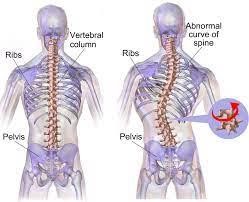A school nurse is performing scoliosis screenings. The nurse should recognize which of the following clinical manifestations as an indication of scoliosis?
Mild pain at the hip region
Uneven shoulder and pelvic heights
Limited range of motion of hips
Exaggerated curvature of the sacrum
The Correct Answer is B
Choice A reason:
Mild pain in the hip region can be caused by various musculoskeletal issues, such as muscle strains, bursitis, or even referred pain from other areas. It is not a characteristic symptom of scoliosis.
Choice B reason
Scoliosis is characterized by an abnormal sideways curvature of the spine, which can cause uneven shoulders and pelvic heights. As the spine curves abnormally, it can lead to asymmetry in the shoulders and hips, which are noticeable during physical examination. This asymmetry is a key clinical sign that suggests the presence of scoliosis.
Choice C reason:
Limited range of motion (ROM) of the hips is more likely related to hip joint issues or musculoskeletal conditions affecting the hips, not specifically scoliosis.
Choice D reason:
Exaggerated curvature of the sacrum may indicate other spinal abnormalities or conditions affecting the lower back, but it is not typically associated with scoliosis, which primarily affects the curvature of the spine higher up in the thoracic or lumbar regions.

Nursing Test Bank
Naxlex Comprehensive Predictor Exams
Related Questions
Correct Answer is D
Explanation
Choice A reason
Ensuring that the client's family supports the provider's decision for surgery is not an appropriate action. While family support is essential in the decision-making process, the primary responsibility lies with the client's health care surrogate or designated decision-maker. The family's support is not a substitute for obtaining informed consent from the designated decision-maker.
Choice B reason
Sending the unsigned informed consent form to the facility's risk manager is not appropriate action. The nurse should not send an unsigned informed consent form to the facility's risk manager. Unsigned consent forms do not have any legal significance or validity. The nurse should work with the health care surrogate to ensure that the consent form is appropriately completed and signed.
Choice C reason
Determining if the procedure is medically necessary for the client is not appropriate action. While the medical necessity of the procedure is important, the decision about the procedure's necessity should be made by the medical team and discussed with the health care surrogate. The nurse's role is to facilitate communication and ensure that the surrogate is informed and involved in the decision-making process.
Choice D reason
When a client is in a coma and unable to provide informed consent, the health care surrogate or designated decision-maker becomes responsible for making medical decisions on behalf of the client. It is essential for the nurse to ensure that the health care surrogate is aware of the situation, understands the risks and benefits of the surgical procedure, and has provided informed consent on behalf of the client.
Correct Answer is D
Explanation
A. This is incorrect because weight gain is not expected in clients who have COPD, as they often have difficulty eating and digesting food due to dyspnea and fatigue.
B. This is incorrect because a decrease in anteroposterior diameter of the chest is not typical of COPD, as the condition causes hyperinflation and air trapping in the lungs, leading to an increase in chest size and a barrel-shaped appearance.
C. This is incorrect because HCO3 24 mEq/L is within the normal range for blood bicarbonate levels, which are 22 to 26 mEq/L. Clients who have COPD often have chronic respiratory acidosis, which stimulates the kidneys to retain bicarbonate and increase its levels in the blood to compensate for the low pH.
D. This is correct because pH 7.31 indicates acidosis, which is common in clients who have COPD due to impaired gas exchange and accumulation of carbon dioxide in the blood.
Whether you are a student looking to ace your exams or a practicing nurse seeking to enhance your expertise , our nursing education contents will empower you with the confidence and competence to make a difference in the lives of patients and become a respected leader in the healthcare field.
Visit Naxlex, invest in your future and unlock endless possibilities with our unparalleled nursing education contents today
Report Wrong Answer on the Current Question
Do you disagree with the answer? If yes, what is your expected answer? Explain.
Kindly be descriptive with the issue you are facing.
